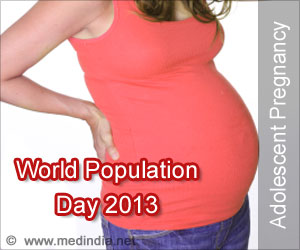Teen pregnancy is still a major challenge in India and is associated with the birth of stunted children, resulting from early marriage. Policies and programs by the Indian government aim to prevent early marriage.
- Teenage pregnancy is still a major challenge in India and results in undernourished and stunted children
- This occurs due to the early marriage of girls before attaining 18 years of age
- The Government of India is implementing policies and programs to curb early marriage in a bid to stop teenage pregnancies
Read More..
Facts about Early Marriage and Teenage Pregnancy in India
- Marriage below 18 years of age is illegal in India
- 27 percent of girls are married off before reaching 18 years, as per the latest data of the National Family Health Survey - 4 (NFHS-4) conducted in 2015-2016
- 31 percent of married women gave birth before the age of 18 years (NFHS-4)
- India is one of the ten countries having the highest number of teenage pregnancies
- Most of the children born to teenage mothers are stunted
- India has the highest number of stunted children in the world
Study Procedure
- Data were analyzed from 60,097 mother-child pairs
- The extent to which teen pregnancy is associated with undernourished children was investigated
- Social, biological, and programmatic factors associated with early pregnancy and child undernutrition was examined
Study Findings
- Prevalence of stunted and underweight children was 10 percent higher in teen mothers than adult mothers
- Teenage mothers exhibited the following characteristics compared to adult mothers:
- They had a shorter stature
- They were more likely to be underweight
- They were more likely to be anemic
- They had a lower level of education
- They had lesser bargaining power
- Their households were poorer
- Their houses had lower levels of sanitation
- They were less likely to access healthcare facilities
- They had poorer complementary feeding practices
What Did the Teen Age Girls (TAG) Survey Reveal?
The TAG Survey was conducted by the Naandi Foundation in 2018. It surveyed 70,000 households across 600 districts in 30 states of India.The survey revealed that 73.3 percent of teenage girls preferred to get married only after 21 years of age, so that they could continue schooling, go to college, and explore job opportunities to progress in life and become financially independent. This is very encouraging. However, these aspirations are usually far from the actual reality, since early marriage is so widely prevalent across India, especially in rural areas, where illiteracy is rampant.
Interestingly, although there has been an overall decline in the prevalence of early marriage over the past decade, it is still very high in states like Andhra Pradesh and Telangana.
“Unfortunately, in India, early marriage and subsequent pregnancy is often not a deliberate choice, but rather the result of an absence of choices, and of circumstances beyond a girl’s control,” says IFPRI Senior Research Fellow and study co-author, Dr. Purnima Menon. She adds: “Continuing schooling, exploring employment opportunities, and delaying marriage and pregnancy are challenges for India’s girls that are reinforced through patriarchy and social norms.”
What Can be Done to End Early Marriage?
Some of the ways to reduce or end early marriage include the following:- Implementation of policies, programs, and legislation to stop early marriage
- Increased investment in interventions targeting adolescents, which include the following:
- Unconditional cash transfers
- Conditional cash transfers upon school enrollment and attendance
- School vouchers
- Life-skills curriculum
- Livelihood training
Conclusion
The Government of India has legal powers for preventing early marriage. Central and state governments have also implemented cash transfer programs which are conditional upon the education of the girl child. Other programs encourage investment in the human capital of girls. Importantly, since the prevalence of early marriage and teen pregnancy are not geographically evenly distributed across India, subnational programs and policies may be required to address the problem.Reference:
- Social, biological and programmatic factors link adolescent pregnancy to early childhood undernutrition: a path analysis of India’s 2016 National Family and Health Survey - (https://www.ifpri.org/news-release/new-study-teen-pregnancy-still-major-challenge-india-strongly-linked-child-stunting)
Source-Medindia
















